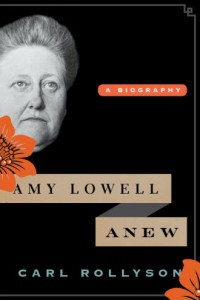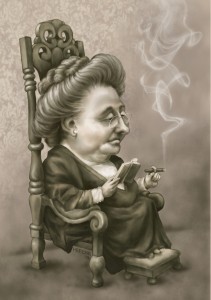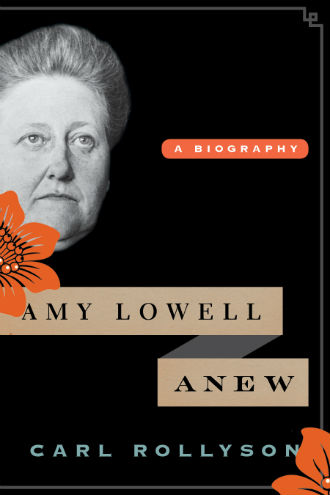 Amy Lowell Anew: A Biography
Amy Lowell Anew: A Biography
by Carl Rollyson
Rowman & Littlefield
256 pages, $34.
INTEREST in poet and iconoclast Amy Lowell (1874–1925) finally seems to be rising after decades of benign neglect. In recent years we’ve seen Adrienne Munich and Melissa Bradshaw’s collection of essays, Amy Lowell, American Modern, and Carl Rollyson’s Amy Lowell among Her Contemporaries. Now Rollyson has added a new book, Amy Lowell Anew, which delves more deeply into the interplay between Lowell’s personal and professional lives. Rollyson had access to the extensive Lowell archive at Harvard University as well as resources in England. And he got help from a few archivists who located new sources, notably an archivist at the Massachusetts Historical Society who found a group of letters referring to a hitherto unknown female companion.
Lowell’s life story is well known: born into a wealthy and influential family, she was a bright and pampered child. She grew up at her family’s estate in Brookline, Massachusetts, and began writing at an early age. Rollyson does a fine job in summarizing Lowell’s early years and her beginnings as a writer and critic. He writes extensively about the poetry movement that was in the air and her discovery that her burgeoning style had a name: “Imagism.” Lowell would later come to feud with the (mostly male) exponents of the Imagist movement. But the feuding didn’t last; Lowell would continue experimenting in her writing. She also wrote reviews and criticism, including a biography of John Keats, and spent much of her time touring the U.S. to do poetry readings.
As for the newly discovered lover, it was around 1903 that Lowell was writing to friends about “Bessie”—Elizabeth Seccombe—who was a friend of a friend and also had a summer home in New Hampshire, not far from her own. The only mentions of Bessie appear in the group of letters that Lowell and Seccombe wrote to Robert Valentine, the newly discovered correspondent. It doesn’t appear that Lowell wrote any love poems for Seccombe, but since the  poet destroyed (or ordered to be destroyed) a lot of her papers and letters, there are tantalizing holes in the record. In any case, the relationship lasted until 1907, when Seccombe wrote to Valentine: “I have left Amy … there seems no chance for our ever meeting again she does not wish it so that ends it.” Lowell herself stopped corresponding with Valentine shortly after the affair with Seccombe ended. The latter died in 1915 on the Lusitania when it was sunk by a German U-boat.
poet destroyed (or ordered to be destroyed) a lot of her papers and letters, there are tantalizing holes in the record. In any case, the relationship lasted until 1907, when Seccombe wrote to Valentine: “I have left Amy … there seems no chance for our ever meeting again she does not wish it so that ends it.” Lowell herself stopped corresponding with Valentine shortly after the affair with Seccombe ended. The latter died in 1915 on the Lusitania when it was sunk by a German U-boat.
It was in 1909 that Lowell met Ada Russell through mutual friends. Russell, an actress, was in Boston appearing in a play, and the women were drawn to each other right away. It appears that after meeting again in 1912, they started the relationship that lasted until Lowell’s death in 1925 at age 51. At the start of the relationship, they weren’t youngsters: Lowell was 38 and Russell (divorced) was 46. They looked very much like a proper “Boston marriage,” but the love poetry shows how erotic a relationship it was. Poems such as “In a Garden” and “Madonna of the Evening Flowers” reveal how adored Russell was by the poet.
Russell—or “Peter,” as Lowell called her—was “majordomo” to the household: she was lover, partner, household manager, and muse. Russell’s daughter and grandchildren were accepted as part of that household, and Amy loved them and spoiled them as her own. As Rollyson points out, Russell brought Lowell a completeness that she never thought she’d have. As a dutiful partner, Russell followed Lowell’s wishes and burned many of her papers, including the letters they wrote early in their relationship. Prior to that, Lowell had commanded that all drafts of her work also be destroyed. All this destruction may partly account for why she left so small a footprint in American letters.
Rollyson suggests that this biography is the first to wholly include Lowell’s sexuality, and he disparages earlier biographers who didn’t take her relationship with Ada Russell seriously. However, it should be noted that in Amy: The World of Amy Lowell and The Imagist Movement (1975), Jean Gould never shied away from this relationship. In fact, she ends the book thus: “Amy Lowell closed hers [i.e., arms] around Ada Russell. And nowhere did she do so with more finality, more complete adoration than in her poem of love, ‘In Excelsis.’”
Lowell identified with John Keats and assembled the largest known collection of his works. She devoted what turned out to be her last four years of life to writing a two-volume biography that lovingly detailed Keats’ own life and loves, and the interplay between the two. This biography, published in the year that she died, along with a posthumous Pulitzer Prize for her volume What’s O’Clock (prepared for publication by Ada Russell), gives Amy Lowell her own place in the literary canon, even if it is a minor one—minor in part because of her early death, but also because her surviving partner chose to remain silent about their relationship. Rollyson puts this relationship front and center to Lowell’s most passionate works: her erotic poetry and her biography of Keats.
Diane Ellen Hamer, a longtime associate of the GLR, is a writer based in Melrose. Mass.






